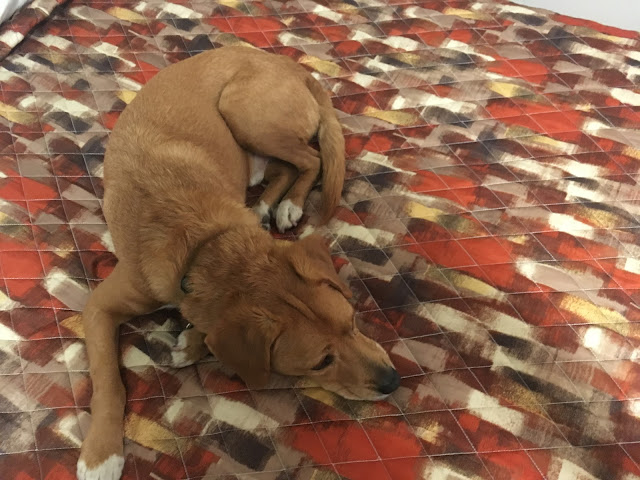"Church Street El", an oil on canvas from 1920, is an overhead view of Broadway and Wall Street, with the elevated train tracks and towering buildings dramatized by bright colors, sharply-defined shadows, and radically simplified shapes. It's all about the dynamism of the Machine Age and seems to reflect a kind of optimism, though it was created by Charles Sheeler only two years after the most destructive war in history...
At first, you might think "City Interior", from 1935, is from a different artist. Here, Sheeler depicts the deep space of the industrial heart of a city in careful detail, with machinery and ductwork casting heavy shadows that contrast with the bright wedge of sky above. At first it could be mistaken for a photograph. But Sheeler has used painterly skills to draw us into the train yard, emphasizing its size and power with the shadowed human figures receding into the distance...
Eight years before, an advertising firm had hired Charles Sheeler to photograph Ford's new River Rouge factories. The integrated facility on 900 acres above the confluence of the River Rouge with the Detroit River had its own steel mill and electric power plant. Featuring buildings designed by Albert Kahn, the Rouge complex was completed in 1928, the year after Sheeler photographed the criss-crossed conveyors above. Few human figures appear in Sheeler's photos of River Rouge. When they do, as in the photo of the giant stamping machine below, they seem overwhelmed by the vast scale and mass of the machines.
By the time Sheeler painted "American Landscape" in 1930, the 1929 Wall Street market crash was sending shock waves through the economy. In "American Landscape", though, the composition seems serene and orderly, with only a tiny human figure running along the train tracks to remind us that people work here. This approach is consistent with Sheeler's view that the giant industrial complexes were the Machine Age equivalent of cathedrals in the medieval era.
Sheeler painted "Classic Landscape", below, in 1931, as the Depression deepened and labor unrest spread among workers who still held jobs. The light-filled order of "Classic Landscape" shows us clearly organized geometry with no humans to create conflict. The diagonal railroad tracks create movement, and underline a sense of power. When Mexican artist Diego Rivera was commissioned by the Detroit Institute of Arts to paint 27 frescoes for its building the next year, he took quite another approach, with two murals showing workers at the River Rouge plant.
By the time Sheeler painted "Rolling Power" in 1939, strikes had exploded across the car industry, with walkouts and sitdown strikes affecting Ford, GM and Chrysler, and men from Ford's Service Dept. attacking labor organizers, including Walter Reuther, on a pedestrian overpass at River Rouge. Where Rivera's murals depicted the roots of human conflict in the era of mass production, Sheeler focused on the detached, impersonal mechanism of power itself. Facing "Rolling Power", you realize it cannot be a photograph, because no functioning locomotive was ever this clean, and everything is in focus, even that puff of steam… Ford's River Rouge plant was the last major Detroit car maker to unionize, in 1941.
By the time Sheeler painted "Incantation" in 1946, critics had labeled his style Precisionism. In this depiciton of an oil facility, the artist has distilled the forms and their shadows into a kind of essence, and the title seems to imply that these forms are, like cathedrals or pyramids, offered as some kind of tribute to a higher power. And ominously, that they may have their own power, detached from, and beyond, the human realm. These implications may resonate as we enter the era of artificial intelligence...
In the painting below from 1949, architectural forms and textures are superimposed and seen from several viewpoints, emphasizing how Sheeler used photography as a tool to advance his grasp of composition.
By "Continuity #2" in 1957, Sheeler was back on the industrial beat, assuming a low vantage point to depict the U.S. Steel blast furnaces in Pittsburgh, assembling the composition of light and shadow by reversing and superimposing photographic negatives to make studies before executing this version in tempera on board. This painting dates from the era that steel and auto companies were at the pinnacle of industrial might in America. As with our first example, "Church Street El", there's not a soul in sight. There is an animating spirit here, but it's all in the geometry...
*Footnote: For perspectives of American landscapes and cityscapes by other artists, you may want to visit these posts on our site:
"Roadside Attraction: John Register's Abandoned Diners and Sleepy Motels", Feb. 24, 2018.
"Roadside Attraction: Night in the City by Wayne Jiang", Feb. 28, 2018.
"Roadside Attraction: The American Gas Station as Visited by Hopper, Evans, Lange, Ruscha and Hitchcock", Nov. 9, 2019.
*Photo Credits:
Top: De Young Museum website
Top: De Young Museum website
2nd: Worcester MA Art Museum
3rd: Metropolitan Museum of Art
4th: Boston Museum of Fine Art and Lane Collection
5th: Museum of Modern Art, New York
6th: The National Gallery, Washington DC
7th: The Philadelphia Museum of Art
8th: The Brooklyn Museum
9th: Artsy.net
10th: Sotheby's









.png)



















































